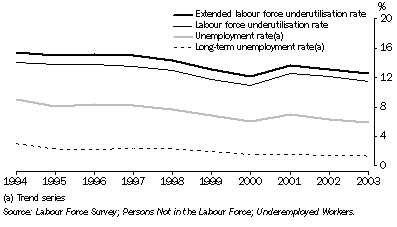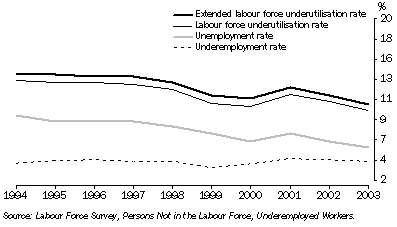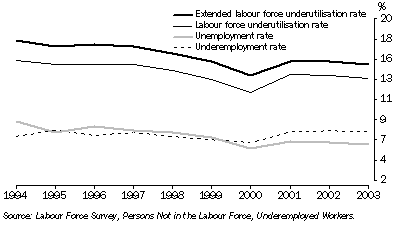Feature Article - Labour Underutilisation
This article was published in the July 2004 issue of Australian Labour Market Statistics (cat. no. 6105.0).
INTRODUCTION
The extent to which the supply of labour is used is an important issue from a number of perspectives. From a social viewpoint, concern may centre around the number of individuals whose aspirations for work are not being met. From an economic perspective, interest may be focussed on measuring the extent to which available labour resources are not being fully utilised within the economy. ABS provides a wide range of data on available labour resources and the extent of labour underutilisation.
The unemployment rate and the number of unemployed people are widely used measures of the available labour resources that are not currently utilised in the economy. However, these measures do not represent the full extent of labour underutilisation. ABS has produced a series of broader measures that include other groups of people whose labour is underutilised, such as underemployed workers and discouraged jobseekers.
The ABS produces labour underutilisation measures based on the number of people whose labour is underutilised. These headcount measures provide an indication of the proportion of the population affected by labour underutilisation. The ABS has also recently developed some experimental volume measures of labour underutilisation, based on the number of hours of available labour that are unutilised. These measures may be more relevant for economic analysis of additional labour force capacity. The methodology for the volume measures is subject to more development work - hence their experimental status.
This article describes the headcount measures of labour underutilisation produced by the ABS, and the population groups that are included in these measures. It presents the first release of updated headcount underutilisation rates for September 2003. The article also includes experimental volume underutilisation rates for September 2003.
HEADCOUNT MEASURES OF LABOUR UNDERUTILISATION
The ABS produces five headcount measures of labour underutilisation, summarised in Table 1. The unemployment rate and long-term unemployment rate have been in use for many years. In February 2002, the ABS introduced two additional headcount measures to supplement these: the labour force underutilisation rate and the extended labour force underutilisation rate. The underemployment rate can also be calculated, as underemployment is a component of the labour force underutilisation rate.
The terms used in the rates in Table 1 are defined below.
The unemployed
The ABS defines unemployed people as those aged 15 or over who were not employed during the reference week, and
- had actively looked for full-time or part-time work at any time in the four weeks up to the end of the reference week and were available for work in the reference week, or
- were waiting to start a new job within four weeks from the end of the reference week and could have started in the reference week if the job had been available then.
The long-term unemployed
The long-term unemployed are people who are currently unemployed, and have been unemployed continuously for 12 months or more.
The underemployed
The ABS defines two groups of underemployed workers:
- part-time workers (i.e. people usually working less than 35 hours a week who did so in the reference week), who want to work additional hours and are available to do so within the next four weeks; and
- full-time workers who worked less than 35 hours in the reference week for economic reasons initiated by their employer (e.g. they had been stood down, put on short time or there was insufficient work available for them). The ABS assumes that persons in this latter group wanted to work full-time in the reference week and would have been available to do so.
The marginally attached
The extended labour force underutilisation rate broadens the measure of underutilised labour to include some people who are not in the labour force. It includes, in addition to the unemployed and the underemployed, two groups of people defined as being marginally attached to the labour force:
- people actively looking for work, who were not available to start work in the reference week, but were available to start work within four weeks; and
- discouraged jobseekers. These are people wanting to work who are available to start work within four weeks and whose main reason for not looking for work was that they believed they would not find a job for reasons associated with the labour market (i.e. considered too young or too old by employers; lacked necessary schooling, training, skills or experience; difficulties with language or ethnic background; no jobs in locality or line of work; or no jobs available at all).
These two groups of people are included in the extended labour force underutilisation rate because they are each close to satisfying the ABS criteria for unemployment. Those in the first group would meet the definition of unemployment if the availability criterion were relaxed by up to four weeks, while those in the second group would be classified as unemployed if the looking for work criterion were relaxed for discouraged jobseekers.
Population counts
Table 2 shows the September 2003 population counts for the various groups that are included in the headcount measures of labour underutilisation.
Table 2, Labour underutilisation, population counts - September 2003 |
|  |
 |  | Males | Females | Persons |  |
 |  | '000 | '000 | '000 |  |
|  |
| Long-term unemployed persons | 84.0 | 45.1 | 129.1 |  |
| Total unemployed persons | 321.0 | 275.2 | 596.3 |  |
| Underemployed workers | 230.5 | 336.8 | 567.4 |  |
 | Underemployed full-time workers | 30.4 | 9.2 | 39.6 |  |
 | Underemployed part-time workers | 200.2 | 327.6 | 527.7 |  |
| Total underutilised labour in labour force | 551.6 | 612.0 | 1,163.6 |  |
| Labour force | 5,609.9 | 4,552.8 | 10,162.6 |  |
| Additional population groups with marginal attachment to the labour force | 43.7 | 75.5 | 119.2 |  |
|  |
| Source: ABS September 2003 Labour Force Survey; Persons Not in the Labour Force, Australia, September 2003 (cat. no. 6220.0); Underemployed Workers, Australia, September 2003 (cat. no. 6265.0). |
TRENDS IN HEADCOUNT MEASURES OF LABOUR UNDERUTILISATION
Overall, movement in unemployment is the primary driver of movements in the headcount measures of labour underutilisation, although underemployment has been increasing in relative importance in recent years, particularly for women. Levels of unemployment, and the unemployment rate, fluctuate with the economic cycle. In the decade to 2003, the trend unemployment rate almost halved, from 11% in September 1993 to 6% in September 2003.
The labour force underutilisation rate in September 2003 was twice the size of the unemployment rate (12% compared with 6%), while the extended labour force underutilisation rate was 13%.
Graph 1, Labour Underutilisation Rates

The labour force underutilisation rate can be obtained by adding the unemployment rate and the underemployment rate. The following graphs show the changes in each of these rates for men and women. For men, the unemployment rate has been consistently higher than the underemployment rate, although the gap between the two has narrowed in recent years. In 1994, men who were unemployed accounted for 71% of all men in the labour force whose labour was underutilised. By 2003, this had declined to 58%.
Graph 2, Labour underutilisation rates - Males

Overall, women have a higher rate of labour force underutilisation than men, due to their higher rate of underemployment, which, in turn, is related to the higher proportion of women who are in part-time employment. Between 1994 and 2003, the rate of underemployment for women was between 1.6 and 1.9 times that of men. In 2000, the unemployment rate for women fell below the underemployment rate and has stayed lower since then. In 2003, unemployed women accounted for 45% of all women whose labour was underutilised.
The extended labour force underutilisation rate for women was also higher than that for men, not only because women had a higher rate of underemployment than men, but also because there was a higher proportion of women in the marginally attached populations that contribute to the extended labour force underutilisation rate.
Graph 3, Labour underutilisation rates - Females

EXPERIMENTAL VOLUME MEASURES OF LABOUR FORCE UNDERUTILISATION
Labour underutilisation can also be measured in terms of the number of hours of available labour in the economy that is not utilised. Such measures may be more relevant for analysing the spare capacity of the labour force. ABS has developed an experimental hours-based (or ‘volume’) version of the labour force underutilisation rate for September 2002 and 2003. Separate rates relating to the volume of unemployment and the volume of underemployment can also be calculated. These three measures are summarised in Table 3.
The volume of potential labour sought or offered by population groups contributing to the experimental volume measures is shown in Table 4. The estimate of the hours of work sought by unemployed persons was derived by applying information on weekly hours sought by unemployed persons from the July survey on Job Search Experience to the numbers of unemployed persons from the September Labour Force Survey.
Table 4, Volume of potential labour in the labour force - number of weekly hours: Experimental measures - September 2003 |
|  |
 |  | Males | Females | Persons |  |
 |  | '000 hours | '000 hours | '000 hours |  |
|  |
| Unemployed persons (hours of work sought) | 10,924.5 | 7,822.8 | 18,747.3 |  |
 | Looking for full-time work | 9,899.7 | 6,022.4 | 15,922.1 |  |
 | Looking for part-time work | 1,024.8 | 1,800.4 | 2,825.2 |  |
| Underemployed workers (additional hours of work offered) | 4,203.3 | 4,806.3 | 9,009.6 |  |
 | Underemployed full-time workers | 778.3 | 203.0 | 981.2 |  |
 | Underemployed part-time workers | 3,425.0 | 4,603.4 | 8,028.3 |  |
| Employed persons (usual hours of work performed)(a) | 218,127.6 | 130,761.2 | 348,888.8 |  |
 | Full-time workers | 205,229.2 | 96,482.9 | 301,712.1 |  |
 | Part-time workers | 12,898.3 | 34,278.4 | 47,176.7 |  |
| Total volume of potential labour in the labour force(b) | 233,255.3 | 143,390.3 | 376,645.7 |  |
|  |
| (a) Actual hours worked in the reference week for underemployed full-time workers and usual hours worked for all other employed persons. |
| (b) The volume of potential labour in the labour force is equal to the hours of labour sought by unemployed persons, plus the hours of labour offered by underemployed workers (both utilised and unutilised), plus the hours of labour usually provided by employed persons who are not underemployed. |
| Source: ABS Labour Force Survey, September 2003; Job Search Experience, Australia, July 2003 (cat. no. 6222.0); Underemployed Workers, Australia, September 2003 (cat. no. 6265.0). |
In September 2003, hours sought by the unemployed formed the largest component of the volume labour force underutilisation rate, accounting for just over two-thirds (68%) of the volume of underutilised labour in the labour force.
On average, unemployed people sought 31 hours of work a week, with men seeking 34 hours compared to 28 hours for women (see Table 5). In contrast, underemployed people offered an average of 16 hours of additional labour, with men again offering more hours (18 hours) than women (14 hours).
TABLE 5, Underutilised labour - mean number of weekly hours sought/offered by selected groups: Experimental estimates - September 2003 |
|  |
 |  | Males | Females | Persons |  |
 |  | hours | hours | hours |  |
|  |
| Unemployed | 34.0 | 28.4 | 31.4 |  |
 | Unemployed seeking full-time work | 37.8 | 33.6 | 36.1 |  |
 | Unemployed seeking part-time work | 17.4 | 18.7 | 18.2 |  |
| Underemployed | 17.7 | 14.2 | 15.6 |  |
 | Underemployed full-time workers | 21.0 | 17.5 | 20.1 |  |
 | Underemployed part-time workers | 17.1 | 14.1 | 15.2 |  |
|  |
| Source: ABS Labour Force Survey, September 2003; Job Search Experience, Australia, July 2003 (cat. no. 6222.0); Underemployed Workers, Australia, September 2003 (cat. no. 6265.0). |
COMPARISON OF HEADCOUNT AND VOLUME MEASURES
Table 6 compares the experimental volume rates with the corresponding headcount rates. For all three measures of labour underutilisation (i.e. unemployment, underemployment and labour force underutilisation), the experimental volume rates for September 2003 were lower than the corresponding headcount rates.
TABLE 6, Measures of labour underutilisation - selected headcount and volume measures: Experimental estimates - September 2003 |
|  |
 |  | Males | Females | Persons |  |
 |  | % | % | % |  |
|  |
| Headcount measures |  |  |  |  |
 | Unemployment rate | 5.7 | 6.0 | 5.9 |  |
 | Underemployment rate(a) | 4.2 | 7.4 | 5.7 |  |
 | Labour force underutilisation rate(a) | 10.0 | 13.5 | 11.5 |  |
| Volume measures |  |  |  |  |
 | Volume unemployment rate | 4.7 | 5.5 | 5.0 |  |
 | Volume underemployment rate | 1.8 | 3.4 | 2.4 |  |
 | Volume labour force underutilisation rate | 6.5 | 8.8 | 7.4 |  |
|  |
| (a) To provide greater comparability with the experimental volume measures, data on the number of underemployed full-time workers are sourced from the Labour Force Survey rather than the Underemployed Workers Survey. |
| Source: ABS Labour Force Survey, September 2003; Job Search Experience, Australia, July 2003 (cat. no. 6222.0); Underemployed Workers, Australia, September 2003 (cat. no. 6265.0). |
Unlike the headcount measures, the volume measures take into account the number of hours worked or sought by individuals and this has the effect of weighting people according to the number of hours they either worked or sought. For example, the large difference between the headcount and volume underemployment rates (5.7% and 2.4% respectively) reflects the large difference between the additional hours offered by the underemployed (15.6 hours a week) and those worked by the employed (36.5 hours).
FURTHER DEVELOPMENTS
The ABS is continuing to develop both its headcount and volume measures of labour underutilisation. Within the next year it plans to: introduce a quarterly series of the (headcount) labour force underutilisation rate; investigate the inclusion of additional population groups within the extended labour force underutilisation rate; continue to develop its experimental volume measures of labour force underutilisation; and pursue discussions aimed at achieving international agreement on definitions and terminology for measures of labour underutilisation.
FOR FURTHER INFORMATION
Information Paper: Measures of Labour Underutilisation (cat. no. 6296.0) describes the concepts behind the ABS headcount measures of labour underutilisation in detail. For further information on the concepts behind the volume measures, see the 'Experimental volume measures of labour underutilisation' article in the July 2003 issue of Australian Labour Market Statistics (cat. no. 6105.0).
For further information, please contact the Assistant Director, Labour Market, on Canberra 02 6252 5603.
For email enquiries, please contact Client Services on client.services@abs.gov.au.
NEW UNDERUTILISED LABOUR SPREADSHEET
A spreadsheet containing labour underutilisation measures is now available. To find the spreadsheet, click here
 Print Page
Print Page
 Print All
Print All